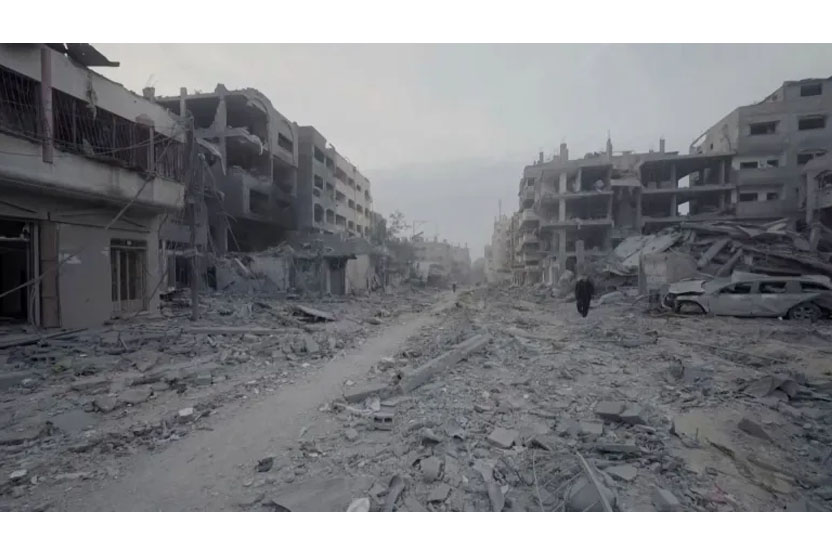The systematic devastation inflicted by Israel in Gaza has obliterated infrastructure and livelihoods across the territory.

The destruction has wiped out every major road, along with electricity and telecommunications networks. Northern Gaza is no longer livable—completely stripped of the basic conditions needed for human life. Its residents bid a final farewell, hearts heavy, hoping one day it will be rebuilt.
According to a new study, the millions of tons of rubble left behind by Israel’s assault on the Gaza Strip could generate over 90,000 tons of greenhouse gas emissions, with cleanup and removal potentially taking up to 40 years.
The report finds that from October 2023 to December 2024, Israel’s widespread destruction of Palestinian homes, schools, hospitals, and infrastructure in Gaza has created at least 39 million tons of concrete debris.
Transporting that amount of rubble to disposal sites would require more than 2.1 million dump truck trips, covering nearly 29.5 million kilometers—equivalent to circling the Earth more than 700 times.
Published in the journal Environmental Research: Infrastructure and Sustainability, the study is part of a growing field aiming to account for the environmental and climate costs of war and occupation, including long-term damage to land, water supplies, food systems, and the immense environmental toll of post-war cleanup and reconstruction.
Conducted by researchers from the Universities of Edinburgh and Oxford in the UK, the study estimates that clearing this rubble alone would produce nearly 66,000 tons of carbon dioxide (CO₂)—not counting the larger environmental footprint of the war itself.
The researchers used advanced open-source satellite imaging tools to detect and analyze conflict-related emissions. Their report is the most detailed yet on the carbon cost and logistical challenge of removing Gaza’s debris—rubble that may contain thousands of unidentified bodies, toxic substances like asbestos, and unexploded ordnance.
They modeled two scenarios to estimate how quickly the debris could be cleared and how much of it might be recycled for rebuilding Gaza.
If 80% of the rubble could be crushed and reused, a fleet of 50 large industrial crushers—currently not allowed into Gaza—could complete the job in just over six months, generating about 2,976 tons of CO₂.
But if using 50 small crushers, the kind typically used in Gaza, the process would take more than 37 years and emit roughly 25,149 tons of CO₂.
In this case, the total CO₂ from transportation and crushing would be equivalent to the carbon footprint of producing 7.3 billion smartphones, according to the researchers.
The longer the contaminated rubble remains, the more it pollutes Gaza’s air and water, posing a severe risk to the two million displaced, starving, and bombarded Palestinians who have been under attack for over 21 months.
The aftermath of Israeli destruction in Gaza’s northeast Rimal neighborhood.
An Act of Ecocide
“The CO₂ emissions from removing and processing the debris may seem small compared to the broader climate cost of Israel’s destruction in Gaza,” said Samer Abdelnour, the lead author of the study and a senior lecturer in strategic management at the University of Edinburgh. “But our analysis sheds light on the sheer scale of the devastation, and just how monumental a task reconstruction will be.”
He added: “While it’s crucial to close the gap in military-related emissions data, our research also offers practical support to Palestinian policymakers, engineers, urban planners, and humanitarian workers striving to rebuild what’s been lost and sustain life on the ground.”
Ben Neimark, a senior lecturer at Queen Mary University of London, praised the study’s rubble-focused approach as a novel angle. “It spotlights the environmental scars left behind after wars, the kinds of damage we often overlook. This research gives us a fresh lens through which to understand those daily images of Gaza’s destruction—placing them in the context of long-term climate impacts.”
Gaza spans just 365 square kilometers, and over 90% of its homes have been damaged or destroyed by Israeli airstrikes—along with the vast majority of its schools, clinics, mosques, and vital infrastructure.
The researchers used a mix of open-source data—building size and height, structural damage assessments, and road network topology—to estimate how rubble is distributed across the territory.
Based on that, they calculated the carbon costs of clearing and transporting the debris as part of any future reconstruction efforts, explained Nicholas Roy, co-author of the study and lead analyst for data collection and modeling.
Since October 7, 2023, Israel’s ongoing assault on Gaza has drawn condemnation from multiple international bodies, with reports accusing Israel of war crimes and crimes against humanity.
It has also led to the deliberate, systematic destruction of Gaza’s environment, making restoration an incredibly difficult task. Many experts have called this an act of ecocide, targeting vital life-support systems for future generations—water resources, farmland, soil, urban areas, and the air itself.



Comment
Reply